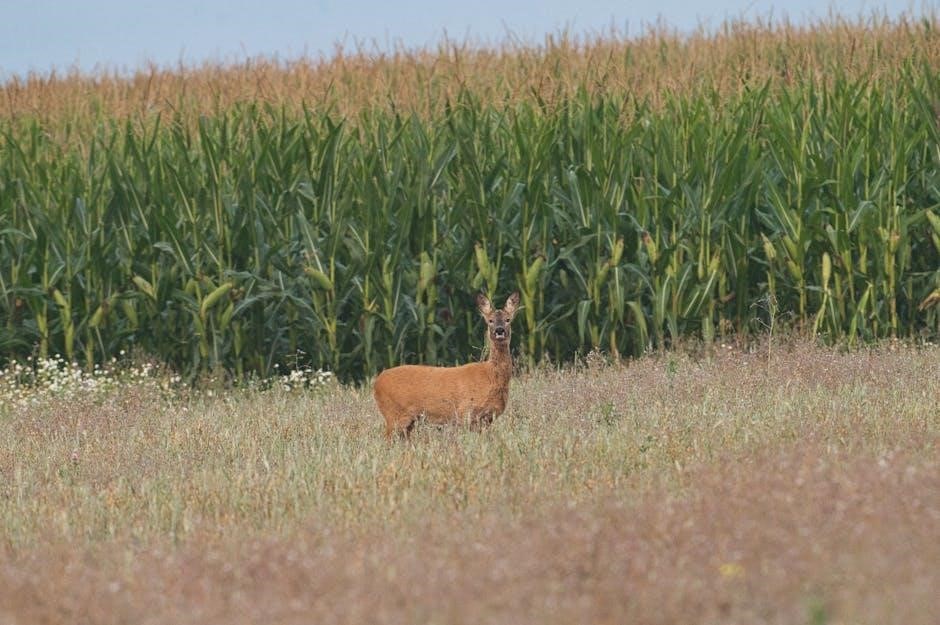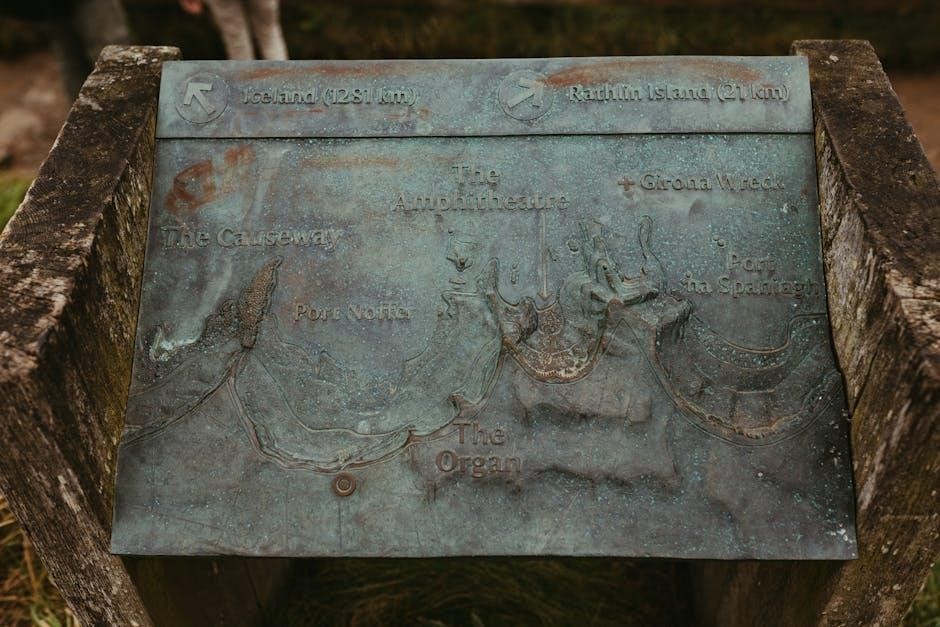The Saskatchewan Hunting Zones Map PDF is a vital resource for hunters, detailing Wildlife Management Zones (WMZs) and essential regulations to ensure responsible and informed hunting practices․
Overview of Wildlife Management Zones (WMZ)
Wildlife Management Zones (WMZ) are administrative regions designated by the Saskatchewan government to manage wildlife populations and their habitats effectively․ Each WMZ is defined based on geographical, ecological, and biological factors, ensuring that hunting regulations align with local wildlife conditions․ These zones help in implementing sustainable hunting practices by dividing the province into areas with distinct wildlife characteristics․ Hunters must understand their specific WMZ to comply with regulations, as each zone may have different rules for species, bag limits, and season dates․ The WMZ system is crucial for maintaining healthy wildlife populations and balancing recreational hunting with conservation efforts․
Purpose of the Saskatchewan Hunting Zones Map
The Saskatchewan Hunting Zones Map is designed to provide hunters with essential information for planning and executing successful hunting trips․ It outlines the boundaries of Wildlife Management Zones (WMZ), season dates, bag limits, and restricted areas․ This tool helps hunters identify legal hunting areas, understand regulations, and ensure compliance with provincial laws․ The map also supports conservation efforts by promoting sustainable hunting practices․ By detailing WMZ-specific rules, it enables hunters to make informed decisions about where and when to hunt․ Both digital and printed versions of the map are available, catering to different preferences and field requirements․ This resource is indispensable for both experienced hunters and newcomers to Saskatchewan․
Importance of Understanding Hunting Zones
Understanding Saskatchewan hunting zones is crucial for legal compliance, conservation, and safety․ Hunters must recognize zone boundaries to avoid trespassing or hunting in restricted areas․ Each zone has unique regulations, season dates, and bag limits, ensuring sustainable wildlife management․ Misunderstanding these boundaries can lead to legal consequences․ Additionally, knowing zones helps hunters plan effectively, targeting specific species in designated areas․ This knowledge also promotes ethical hunting practices, respecting both the environment and wildlife․ By understanding zones, hunters contribute to conservation efforts while enjoying their sport responsibly․ Accurate zone knowledge enhances safety and ensures a positive hunting experience in Saskatchewan’s diverse landscapes․ Proper preparation is essential for success․

Accessing the Saskatchewan Hunting Zones Map PDF
The Saskatchewan Hunting Zones Map PDF is available on the Ministry of Environment’s website and through the MyWildlifePortal․ It is free to download annually․
Downloading the Map from Official Sources
The Saskatchewan Hunting Zones Map PDF can be downloaded directly from the Ministry of Environment’s official website or through the MyWildlifePortal․ This ensures users access the most accurate and up-to-date information․ The map is available free of charge and is typically updated annually to reflect any changes in zone boundaries or regulations․ To download, visit the Ministry’s website, navigate to the hunting section, and select the PDF option; The file is in a searchable and printable format, making it easy to reference specific zones or plan hunting trips․ Always download from official sources to avoid outdated or incorrect data․ This ensures compliance with current regulations and enhances your hunting experience․
Printing the Map for Field Use
Printing the Saskatchewan Hunting Zones Map PDF is a practical step for field use, ensuring you have a reliable reference even without internet access․ The map is designed in a high-resolution PDF format, making it suitable for large-scale printing․ Print it on durable paper or laminate it for protection against weather conditions․ Ensure the scale is set correctly to maintain accuracy․ A printed map allows for easy navigation and quick identification of zone boundaries, season dates, and restricted areas․ It’s also useful for marking locations of interest or noting access points․ Always carry a printed copy as a backup to digital tools․ This ensures you stay informed and compliant during your hunt․
Using Digital Tools for Interactive Mapping
Digital tools offer an enhanced experience when navigating the Saskatchewan Hunting Zones Map PDF․ Interactive mapping platforms allow users to zoom, pan, and search specific locations effortlessly․ Layers can be toggled to display WMZ boundaries, season dates, and restricted areas in detail․ Real-time updates ensure hunters have the most current information․ GPS integration enables precise location tracking, making it easier to identify hunting zones in the field․ These tools are accessible via smartphones and tablets, providing portability and convenience․ They also reduce reliance on physical maps, though printed versions remain useful as backups․ Digital tools are indispensable for modern hunters, offering flexibility and accuracy for planning and executing successful hunts․

Understanding WMZ Boundaries and Regulations
Understanding WMZ boundaries and regulations is crucial for legal and ethical hunting practices in Saskatchewan․ These boundaries define specific hunting areas, ensuring sustainable wildlife management and conservation efforts․
Interpreting Zone Boundaries on the Map
Interpreting zone boundaries on the Saskatchewan Hunting Zones Map PDF requires careful attention to visual details․ The map uses distinct colors, labels, and symbols to outline Wildlife Management Zones (WMZs), ensuring clarity for hunters․ Each zone is clearly demarcated, with boundaries often following natural or man-made features like rivers, roads, or administrative borders․ Hunters should refer to the map legend to understand the coding system, as colors and labels correspond to specific zones․ Accurate interpretation is essential for legal compliance and effective hunt planning․ Cross-referencing with official resources ensures up-to-date information, as boundary adjustments may occur to reflect conservation priorities or administrative changes․
Regulations Governing Hunting in Saskatchewan
Hunting in Saskatchewan is governed by a comprehensive set of regulations designed to ensure sustainable wildlife management and public safety․ These rules, outlined in the Saskatchewan Hunting Zones Map PDF, include season dates, bag limits, and gear restrictions for various species․ Hunters must adhere to specific permits and licenses required for different Wildlife Management Zones (WMZs)․ The regulations also address ethical hunting practices, such as fair chase and humane harvesting․ Compliance with these rules is essential to avoid legal penalties and to conserve wildlife populations for future generations․ Additionally, hunters are encouraged to report violations to support conservation efforts and maintain healthy ecosystems․
Sunrise and Sunset Time Calculations
Calculating sunrise and sunset times in Saskatchewan is essential for hunters to adhere to legal hunting hours, typically from a half-hour before sunrise to a half-hour after sunset․ The Saskatchewan Hunting Zones Map PDF divides the province into Wildlife Management Zones (WMZs), each with varying daylight hours due to Saskatchewan’s vast geography․ Hunters can use an interactive map tool linked to the PDF, which may provide real-time data based on GPS coordinates․ Additionally, reliable weather websites or apps can offer location-specific times․ For precision, astronomical data using date, latitude, and longitude can be applied, though this may be complex․ The Ministry of Environment may offer specific tools for hunters, ensuring compliance with regulations and promoting ethical practices․

Key Features of the Saskatchewan Hunting Zones Map
The Saskatchewan Hunting Zones Map PDF highlights WMZ boundaries, season dates, bag limits, and protected areas, ensuring hunters can plan effectively while complying with regulations․
Visual Representation of WMZs
The Saskatchewan Hunting Zones Map PDF provides a clear and detailed visual representation of Wildlife Management Zones (WMZs), using distinct colors and symbols to differentiate zones․ This visual layout allows hunters to quickly identify WMZ boundaries and understand spatial relationships between zones․ The map employs shading and patterns to highlight specific areas, ensuring that hunters can easily distinguish between zones at a glance․ Additionally, the visual elements are supported by a legend that explains the meaning of symbols and colors, making the map user-friendly․ This clear visual representation is essential for hunters to navigate the terrain effectively and ensure they are hunting in the correct WMZs․
Season Dates and Bag Limits
The Saskatchewan Hunting Zones Map PDF includes detailed information on season dates and bag limits for various wildlife species within each WMZ․ Hunters can find specific start and end dates for different game species, ensuring compliance with provincial regulations․ Bag limits are clearly outlined to promote sustainable hunting practices and conserve wildlife populations․ These details are essential for planning hunts, as they vary by zone and species․ The map also highlights special restrictions or exceptions, providing a comprehensive guide for hunters to stay informed and adhere to legal requirements․ This information ensures ethical and responsible hunting practices across Saskatchewan’s diverse WMZs․
Protected Areas and Restricted Access Zones
The Saskatchewan Hunting Zones Map PDF identifies protected areas and restricted access zones where hunting is prohibited or limited․ These areas include national parks, wildlife refuges, and ecological reserves, which are critical for conservation efforts․ Additionally, some zones may have restricted access due to private property, sensitive habitats, or cultural significance․ Hunters must ensure they avoid these areas to comply with legal and ethical hunting practices․ The map provides clear boundaries and labels for these zones, helping hunters plan their trips responsibly․ Understanding these restrictions is essential to preserving Saskatchewan’s natural heritage and ensuring sustainable wildlife management․ Always refer to the map for precise locations and details․

Updates and Changes to Hunting Zones
The Saskatchewan government periodically updates hunting zones to reflect conservation needs, public input, and environmental changes․ Stay informed through official sources for the latest adjustments․
New Antlerless Draw Seasons
The Saskatchewan government has introduced new antlerless draw seasons to manage deer populations effectively․ These seasons aim to balance harvest levels with conservation goals, ensuring sustainable wildlife management․ Hunters can apply for special permits through the draw system, which allocates opportunities based on zone-specific quotas․ The antlerless seasons are typically held outside the regular hunting season to target does and fawns, helping maintain healthy herd structures․ Detailed information, including application deadlines and zone restrictions, is outlined in the Saskatchewan Hunting Zones Map PDF and on the Ministry of Environment’s website․ This initiative supports both ecological balance and hunter participation in resource management․
Extended Hunting Seasons in Specific Zones
The Saskatchewan Hunting Zones Map PDF highlights extended hunting seasons in designated areas to manage wildlife populations and provide additional opportunities for hunters․ These extensions are implemented in zones where animal numbers are abundant or where seasonal conditions warrant longer harvest periods․ The map identifies zones with extended seasons, specifying the types of game and applicable dates․ Hunters must consult the map to ensure compliance with zone-specific regulations․ Extended seasons are designed to balance ecological needs and hunter demand, ensuring sustainable practices․ By referencing the map, hunters can plan effectively and take advantage of these extended opportunities while adhering to provincial wildlife management objectives․
Boundary Adjustments for Conservation
The Saskatchewan Hunting Zones Map PDF often includes boundary adjustments to align with conservation goals․ These changes aim to protect sensitive habitats, manage wildlife populations, and balance hunter access with ecological needs․ Adjustments may expand or reduce zone sizes based on environmental assessments and species data․ Hunters must stay informed about these modifications, as they can affect where and when hunting is permitted․ By updating zone boundaries, the province ensures sustainable wildlife management and maintains healthy ecosystems․ Regularly reviewing the map helps hunters adapt to these changes and comply with regulations designed to conserve Saskatchewan’s natural resources for future generations․

Hunting Licenses and Permits
Hunting in Saskatchewan requires proper licenses and permits, ensuring compliance with local regulations․ The Saskatchewan Hunting Zones Map PDF helps identify necessary documentation for specific regions and species․
License Requirements for Different Zones
The Saskatchewan Hunting Zones Map PDF outlines specific license requirements for each WMZ, ensuring hunters comply with regional regulations․ Residency status, age, and game type influence license types․ For instance, residents and non-residents have distinct permits, while youth and seniors may qualify for special licenses․ Zones with high conservation needs may require additional tags or permits for species like deer or elk․ The map helps identify zones with restricted access or special permits, ensuring hunters obtain the correct documentation․ Understanding these requirements is crucial for legal and ethical hunting practices․ Always verify details with the Saskatchewan Environment website for accuracy․ Proper licensing ensures sustainable hunting and conservation efforts․
Impact of Zone Changes on Licenses
Changes to Saskatchewan hunting zones can significantly affect license requirements․ Shifts in WMZ boundaries may invalidate existing licenses or require updates․ Hunters must ensure their licenses align with the new zone designations․ For example, moving a hunting location to a different zone might necessitate a new permit․ Season dates and bag limits tied to specific zones may also change, impacting license validity․ It’s crucial to review updated maps and regulations annually․ The Ministry of Environment communicates these changes, ensuring hunters adapt to new requirements․ Failing to update licenses could result in legal issues․ Always verify zone changes before applying for or using a hunting license․
Obtaining Permits for Special Hunts
Special hunts in Saskatchewan, such as antlerless deer or conservation hunts, require additional permits․ These permits are issued to manage specific wildlife populations or promote conservation efforts․ Hunters must apply through the Saskatchewan Ministry of Environment’s official website or at local field offices․ Applications typically open during specific periods, and some permits are allocated through a draw system․ Required documentation, such as a valid hunting license, must be provided․ Fees for special permits vary, and availability is limited to ensure sustainable practices․ Hunters should check the Saskatchewan hunting zones map PDF to identify eligible areas and review application deadlines to avoid missing opportunities․ Always ensure compliance with permit regulations to participate legally in special hunts․

Wildlife Conservation and Management
The Saskatchewan hunting zones map PDF plays a vital role in wildlife conservation by designating WMZs to protect habitats and regulate hunting practices, ensuring sustainable wildlife populations․
Role of WMZs in Wildlife Conservation
The WMZs outlined in the Saskatchewan hunting zones map PDF are essential for wildlife conservation, as they divide the province into areas with distinct ecological characteristics․ By managing these zones, conservation efforts can be tailored to protect specific species and their habitats․ The WMZ system ensures sustainable hunting practices by regulating harvest levels and maintaining healthy wildlife populations․ It also allows for the monitoring of species distribution and habitat changes over time, enabling proactive measures to address threats like climate change or habitat loss․ This zoned approach supports biodiversity and ensures that hunting remains a viable and environmentally responsible activity for future generations․
Monitoring Wildlife Populations
The Saskatchewan hunting zones map PDF plays a crucial role in monitoring wildlife populations by providing a framework for data collection and analysis․ Wildlife Management Zones (WMZs) allow biologists to track species distribution, density, and migration patterns within specific areas․ This data is collected through surveys, hunter harvest reports, and field observations․ By analyzing population trends, conservationists can identify areas where species may be declining or thriving; This information is vital for setting sustainable hunting regulations and ensuring the long-term health of wildlife․ Accurate monitoring also helps address environmental challenges and supports adaptive management strategies, balancing human activities with ecological preservation․ This ensures that hunting remains compatible with conservation goals․
Ensuring Sustainable Hunting Practices
The Saskatchewan hunting zones map PDF is essential for promoting sustainable hunting practices by balancing wildlife conservation with recreational hunting․ By dividing the province into WMZs, the map helps manage game populations and prevent overharvesting․ Hunters can use the map to identify areas with healthy wildlife numbers, ensuring that hunting pressures remain sustainable․ Season dates, bag limits, and restricted zones are designed to protect vulnerable species and habitats․ This approach supports long-term ecological balance, allowing wildlife to thrive while providing opportunities for ethical hunting․ The map also encourages hunters to adopt responsible practices, fostering a culture of conservation and respect for Saskatchewan’s natural resources․

Using the Saskatchewan Interactive Map Tool
The tool offers real-time updates and enhanced navigation, featuring zone searches, interactive layers, and a user-friendly interface․ It is compatible with both desktop and mobile devices, ensuring accessibility for all hunters․
Navigating the Interactive Map
Navigating the Saskatchewan Interactive Map Tool is straightforward, with intuitive controls for zooming, panning, and searching specific locations․ Users can easily toggle between map layers, such as satellite imagery or topography, to enhance visibility․ The tool also supports touch gestures for mobile devices, making it accessible on the go․ A search bar allows hunters to quickly locate WMZs or landmarks․ Additionally, the map features a measuring tool to calculate distances, ensuring accurate navigation in the field․ Detailed instructions and a legend are provided to guide users through its features, making it a robust resource for planning and executing hunting trips effectively․
Customizing Maps for Specific Needs
The Saskatchewan Interactive Map Tool allows users to customize maps according to their hunting requirements․ Hunters can highlight specific WMZs, overlay season dates, and display protected areas or restricted zones․ Custom markers can be added for key locations like parking spots, trailheads, or stands․ Users can also adjust map layers to focus on topography, satellite imagery, or road networks․ This feature ensures hunters can tailor the map to their exact needs, streamlining planning and preparation․ Customized maps can be saved and shared, making it easier to coordinate with hunting partners or revisit preferred locations in future trips․ This flexibility enhances the tool’s practicality for hunters․
Integrating GPS Coordinates
Integrating GPS coordinates into the Saskatchewan Hunting Zones Map enhances navigation and precision for hunters․ The interactive tool allows users to input GPS coordinates, marking specific locations such as hunting stands, blinds, or trailheads․ This feature enables precise tracking of positions relative to WMZ boundaries, ensuring compliance with regulations․ Hunters can also export coordinates for use in GPS devices, simplifying field navigation․ Additionally, the tool supports real-time tracking, helping hunters stay aware of their location within WMZs․ This integration is invaluable for planning routes, identifying access points, and ensuring safe, legal hunting practices․ It bridges the gap between digital planning and on-the-ground execution seamlessly․

Planning Your Hunting Trip
Planning your hunting trip involves using the Saskatchewan Hunting Zones Map PDF to identify areas, check regulations, and prepare gear and strategies for a safe, efficient hunt․
Identifying Hunting Areas
The Saskatchewan Hunting Zones Map PDF is essential for identifying suitable hunting areas by detailing WMZs and game species distribution․ Hunters can locate public and private lands, ensuring they stay within legal boundaries․ The map highlights protected areas, national parks, and restricted zones, helping hunters avoid unintentional trespassing․ By understanding WMZ boundaries, hunters can select areas with appropriate game populations and accessible terrain․ Digital tools also allow real-time updates, ensuring accuracy․ Always cross-reference the map with local regulations to confirm access rights․ This step is crucial for planning a lawful and enjoyable hunting experience in Saskatchewan’s diverse landscapes․
Visit official sources for the most current map data․
Checking Zone-Specific Regulations
Checking zone-specific regulations is crucial for compliance and a successful hunt․ The Saskatchewan Hunting Zones Map PDF outlines unique rules for each WMZ, including season dates, bag limits, and gear restrictions․ Hunters must verify permits, licensing requirements, and any special restrictions, such as firearm use or baiting․ Protected areas and Indigenous reserves are clearly marked, ensuring hunters avoid illegal access․ Seasonal adjustments and emergency closures are also noted, making it essential to consult the latest updates․ Adhering to these regulations helps conserve wildlife and ensures a sustainable hunting practice․ Always cross-reference the map with official government sources for the most accurate information․
Stay informed to avoid legal issues and respect wildlife habitats․
Preparing for Your Hunt
Preparing for your hunt involves more than just gear; it requires a thorough understanding of the Saskatchewan Hunting Zones Map PDF․ Ensure your firearms and equipment meet provincial standards, and familiarize yourself with the terrain using topographic data․ Plan your route, considering access points and potential challenges like weather conditions․ Pack essentials like licenses, first aid kits, and communication devices․ Study the map to identify boundaries and landmarks, and mentally prepare for varying conditions․ Physical conditioning and knowledge of survival skills are also crucial․ Respect the environment by following “leave no trace” principles and adhering to safety guidelines to ensure a responsible and enjoyable hunting experience․
A well-prepared hunter is a safe and successful one․

Additional Resources for Hunters
Topographic maps, aerial photographs, and ministry field offices provide essential insights, while hunter education resources enhance safety and awareness․
These tools complement the Saskatchewan Hunting Zones Map PDF․
Topographic Maps and Aerial Photographs
Topographic maps and aerial photographs are invaluable resources for hunters, offering detailed insights into Saskatchewan’s terrain, water bodies, and vegetation patterns․
These tools help identify potential habitats for wildlife, such as wetlands, forests, and ridges, while also aiding in navigation and planning routes․
Aerial imagery provides a bird’s-eye view, revealing landscape features that may not be visible on standard hunting zone maps․
By combining these resources with the Saskatchewan Hunting Zones Map PDF, hunters can gain a comprehensive understanding of their hunting areas․
Both topographic maps and aerial photographs are available through Natural Resources Canada and provincial mapping platforms․
They are essential for pre-hunt planning and enhancing success in the field․
Ministry of Environment Field Offices
The Ministry of Environment Field Offices serve as vital resources for hunters seeking information on Saskatchewan’s hunting zones and regulations․
Located throughout the province, these offices provide personalized assistance, including detailed maps and guidance on interpreting the Saskatchewan Hunting Zones Map PDF․
Staff can offer insights into local wildlife populations, habitat conditions, and any recent changes to hunting zones or rules․
Hunters can visit these offices to obtain printed copies of the map or discuss specific hunting plans with knowledgeable personnel․
Additionally, the offices provide updates on conservation efforts and offer tips for responsible hunting practices․
Contact information for local field offices is available online or through provincial government resources․
They are an essential resource for ensuring a safe and compliant hunting experience in Saskatchewan․
Hunter Education and Safety Resources
Hunter education and safety resources are essential for ensuring responsible and safe hunting practices in Saskatchewan․
The province offers certified hunter education courses, which cover firearms safety, wildlife ethics, and outdoor survival skills․
These programs are mandatory for first-time hunters and provide a solid foundation for safe and ethical hunting practices․
Additional safety resources include guides on tree stand safety, firearm handling, and emergency preparedness․
Hunters can access these resources through the Saskatchewan Ministry of Environment website or local hunting organizations․
Staying informed about safety protocols and best practices is crucial for a successful and enjoyable hunting experience․
The Saskatchewan Hunting Zones Map PDF is an essential guide for hunters, ensuring compliance with regulations and promoting sustainable hunting practices across the province․
Final Thoughts on the Saskatchewan Hunting Zones Map
The Saskatchewan Hunting Zones Map PDF is a vital resource for hunters, providing clear boundaries and regulations to ensure ethical and legal hunting practices․ By understanding WMZs, hunters can make informed decisions, contributing to wildlife conservation․ The map’s detailed information empowers hunters to plan effectively, respect protected areas, and adapt to seasonal changes․ Its availability in both digital and print formats makes it accessible for all hunters․ Staying updated with the latest versions ensures compliance with evolving regulations․ Ultimately, the map is a cornerstone for responsible hunting in Saskatchewan, fostering a balance between recreation and conservation․ Always refer to it before heading out․
Staying Informed for Future Hunts
To ensure a successful and compliant hunting experience in Saskatchewan, it’s crucial to stay informed about updates to the hunting zones map and related regulations․ Regularly check the official Saskatchewan Environment website for the latest versions of the map and any changes to WMZ boundaries or season dates․ Subscribe to newsletters or follow government social media pages for timely updates․ Hunters should also download the latest map before each hunting season to ensure they have the most accurate information․ Staying informed helps prevent legal issues and ensures hunters are always aware of protected areas and access restrictions․ Proactive planning and knowledge are key to responsible hunting practices in Saskatchewan’s diverse landscapes․
